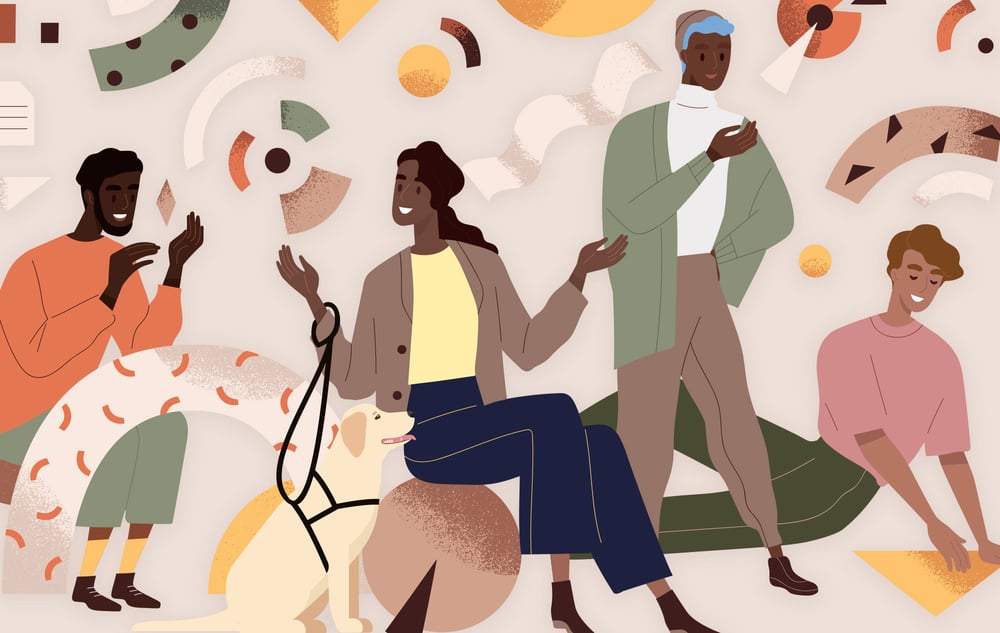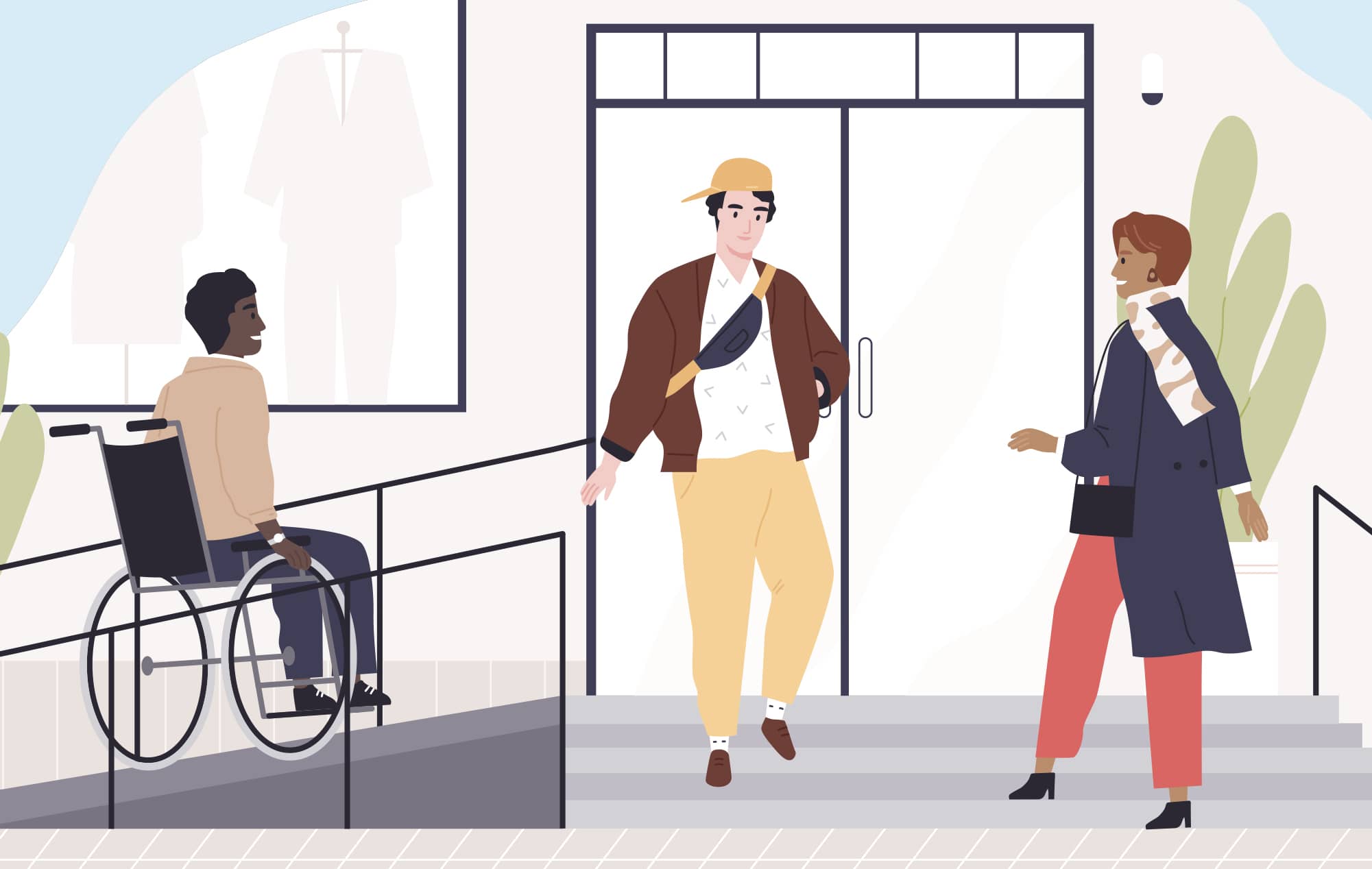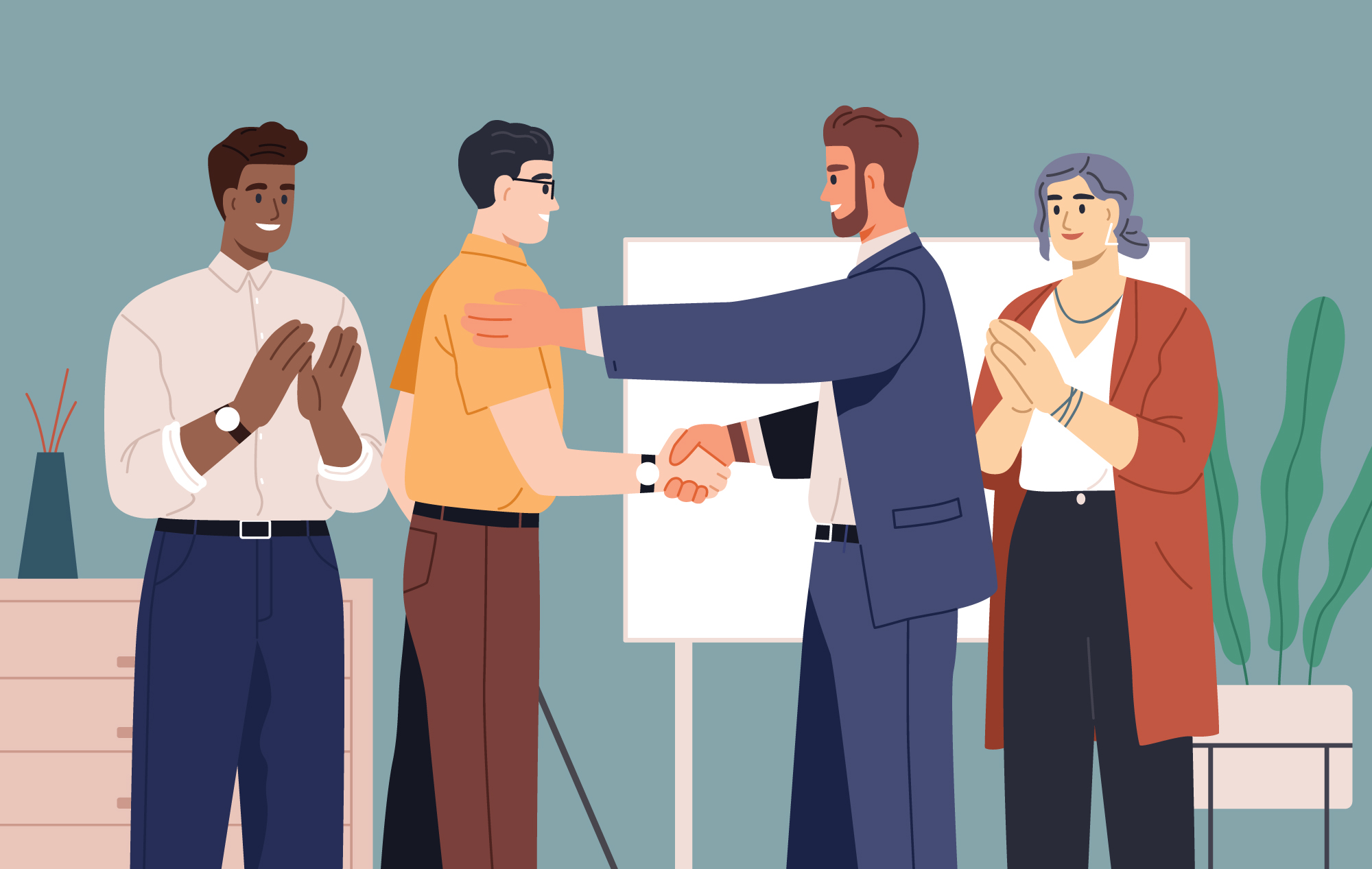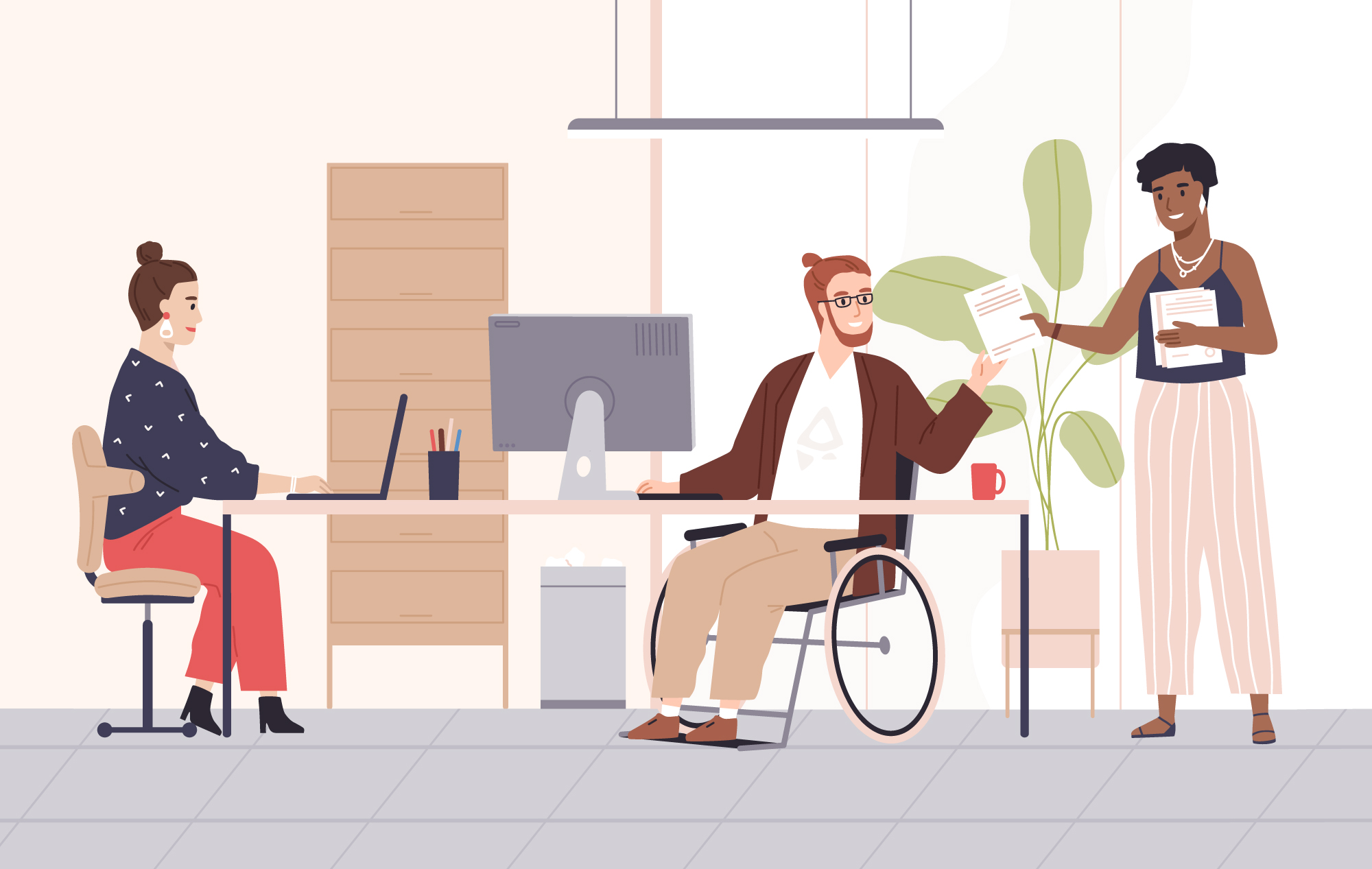Many barriers remain for professionals with disabilities, despite meaningful progress made since the 1960s—both legislative and cultural.
Fortunately, more and more organizations are prioritizing accessibility, inclusion, and belonging in the workplace. Making life better for those who have been historically marginalized or excluded isn’t just “the right thing to do” or good business practice. While these things are true, improving inclusion and belonging in the workplace also makes life better for everybody else.
Eager to remedy past and ongoing injustices, Salesforce, a founding partner of InclusionHub, has focused on nurturing such a culture throughout its company.
Here’s a breakdown of what accessibility, inclusion, and belonging mean, and stories of what they look like in the professional world.

What Is the Difference Between Accessibility, Inclusion & Belonging?
While thrown around frequently and used interchangeably, it’s helpful to understand the distinctions between accessibility, inclusion, and belonging, since each concept has a specific aim. An organization can be accessible or inclusive, for example, but still fail to develop a genuine culture of belonging.
So what do each of these mean?
Accessibility
In simple terms, accessibility—or a11y, its shorthand form—is about ensuring everybody is able to fully participate in daily and professional activities, regardless of disability status.
This can include integrating wheelchair ramps and automatic doors into building design, permitting employees to work remotely, offering mental health days, providing screen readers for employees, and implementing captions into virtual team meetings, to name a few examples.
When it comes to company websites or digital platforms, accessibility can include:
- Alt text to benefit professionals that are blind or visually impaired (BIV) and others relying on screen readers
- Eschewing autoplay-background audio on websites, which can confound the user experience for people with cognitive disabilities and learning disorders
- Removing irregular navigation patterns that can discourage professionals with physical disabilities from fully engaging
Inclusion
While accessibility ensures everybody has the means to enter spaces where decisions are made and professional work is accomplished, inclusion means opportunities are available for people with disabilities to contribute once they are there. It’s about nurturing professional practices and norms to where everyone is part of the conversation.
In the workplace, this might entail having marketing material that includes representations of professionals with disabilities and other marginalized communities.
It means embracing inclusive hiring practices, such as posting job descriptions with language highlighting your commitments to accessibility and inclusion, or asking candidates for any accommodations they may require.
Inclusive interview practices might involve “access checks” during virtual interviews and focusing on competency-based hiring rather than vague notions of “culture fit,” which often allow biases against people with disabilities to creep in.
Belonging
Going one step further, belonging is about creating a strong sense of acceptance and support for professionals with disabilities. When you have a workplace culture that encourages workers to bring their whole selves into the office—rather than causing them to feel a need to conceal their disability status—then you can have confidence you’re fostering a spirit of belonging.
Belonging contrasts with tolerance, which can often take the form of indifference to others, or even quiet disdain. Belonging is about creating a strong sense that someone has a place on your team.
To really appreciate the impact of these changes in work culture, it helps to understand some of the history around accessibility in the United States.

A Brief History of A11Y in America
Prior to the 1960s, many people with disabilities were severely discriminated against, prevented from gainful employment, marginalized, and, in some cases, completely segregated from the rest of civic and social life.
Motivated by the incredible energy surrounding the Civil Rights Movement at the time, disability advocates believed they could generate momentum to turn the tide against centuries of cruelty and condescension. Alongside allies, people with disabilities began breaking into the mainstream, challenging stereotypes and barriers that had been preventing the disabilities community from fully participating in society.
Cultural shifts were soon met with legislative changes, such as the passage of Section 504 of the Rehabilitation Act of 1973, making it illegal for entities receiving federal funding to discriminate against people with disabilities. Section 508 of the act was updated in 1998, providing standards for how federal information should be communicated electronically to make it more accessible for people with disabilities.
Further clarifications and expansions to Section 508 were included in 2017.
The Americans With Disabilities Act
Building on previous legislative keystones, the Americans With Disabilities Act of 1990 (ADA) further enshrined goals advanced by disability advocates. This ensured freedom from discrimination in employment, and provided greater accessibility within every level of government and aspect of public life.
With strong bipartisan support, the ADA was signed into law by President George H.W. Bush on the front lawn of the White House, with roughly 3,000 disability advocates in attendance.
Several challenges to the new law were soon brought forward. For instance, in Sutton v. United Airlines, the Supreme Court ruled in favor of the airline’s ability to deny employment to Karen Sutton and Kimberly Hinton, despite their visual myopia being correctable with lenses. Many of these lost cases were the result of a poorly worded definition of “disability.”
To buttress against these continuing forms of discrimination, Congress passed the ADA Amendments Act of 2008—providing more individuals with disabilities the protections necessary for equal access.
A11y & Inclusion Progress Globally
Disability advocacy has gained traction globally, as well. For instance, the United Nations (UN) has prioritized accessibility and inclusion in its Sustainable Development Goals (SDGs), which it adopted in 2015. Many of these goals aim at reducing inequalities and promoting inclusive and decent work for all.
To achieve these aims requires the support of not only local and national governments, but businesses as well.
For instance, Salesforce has demonstrated a commitment to these goals by establishing an Office of Accessibility to ensure all stakeholders, including people with disabilities, can contribute to an equitable and sustainable future. Salesforce has also launched a publicly facing a11y website to accelerate these efforts.
While legislative and cultural milestones have brought about monumental changes, much progress remains to be made—particularly in the workplace.

Power of Partnerships in A11Y Work
To create meaningful changes in the professional world takes a blend of businesses and nonprofits partnering together, and Salesforce is currently engaged in several, knowing these partnerships can create ripple effects, one organization or employee at a time.
Such is the case with the Blind Institute of Technology (BIT), Project Soar, and Fable.
Blind Institute of Technology & Project Soar
Founded more than 10 years ago by Mike Hess, BIT focuses on overcoming both the so-called “unemployment gap” and “digital divide” facing blind or visually impaired (BVI) professionals to help ensure their gainful employment. Salesforce’s Office of Accessibility works directly with BIT to provide people within the BVI community the training necessary to become Salesforce administrators—which has had a domino effect for other Sustainable Development Goals outlined by the UN.
For instance, graduates of BIT’s Salesforce Admin Certification Prep course have partnered with Project Soar, a Morocco-based nonprofit providing programs and educational opportunities to help adolescent girls “understand [their] value, voice, body, rights, and path.”
In Morocco, teen girls from rural and marginalized communities routinely face human rights threats including child marriage. Project Soar’s programs focus on developing their confidence, community awareness, and skills around related issues. For instance, program participants learn about entering, tracking, aggregating, and reporting on impact data.
That data is collected and shared with local or state governments to show how they can invest in similar programs and improve the lives of young girls throughout the country.
“At its heart, our mission is to leverage Salesforce as a vehicle to empower a super marginalized community,” said BIT founder Mike Hess. “To say I’m a fan of Salesforce and the work we’re doing is an understatement.”
Empowerment is an important part of fostering a more inclusive future, but in the digital age, this also needs to translate to accessible web design.
Fable
Fable, a leading accessibility platform powered by people with disabilities, was founded in 2018 specifically to facilitate organizations designing and building accessible and inclusive products.
In addition to Walmart, Shopify, and Slack, Fable also partners with Salesforce to help connect them with people with disabilities for testing, researching, and developing digital products. Fable maintains an accessibility testing community consisting of people with disabilities who utilize assistive technologies—testers compensated at rates competitive within the tech industry.
As industry leaders lean into inclusive design, other competitors in their sectors tend to follow suit, but many need guidance on how to be more accessible. To this end, Salesforce, Fable, vision-assistance app Be My Eyes, and HubSpot Partner Agency Morey Creative Studios have partnered together to create InclusionHub, an online community, directory, and resource helping businesses prioritize accessibility, inclusion, and belonging—and celebrate when they do.
To truly appreciate what those developments can do, we need to look at life as a professional with a disability and which forms further progress may take.

Life as a Professional With a Disability
While stigmas, stereotypes, and discrimination are common experiences for professionals with disabilities, their manifestations are varied and unique.
Here are a few stories from the lives of professionals within the disabilities community—challenges, successes, and recommendations for creating a more inclusive future.
A Day in the Life of Blind or Visually Impaired Professionals
As for many professionals with disabilities, one of the greatest challenges they face is stigma. They perpetually must push back against the notion that they don’t belong in the workplace or are incapable of contributing.
Crystal Preston-Watson, a Senior Digital Accessibility Analyst at Salesforce who uses an eye patch, believes this stereotype persists because many professionals lack friendships with people with disabilities.
“It shows that in their personal life they probably don’t have an outward relationship with people with disabilities,” Preston-Watson says. “That's really the key perception when it comes to employment.”
To further fight against this stereotype, she says BVI professionals have to work even harder.
“‘It's like, ‘Oh, someone who is blind, well, they're not going to be able to do anything, there's no way,’” she continues. “There's the perception that if you're blind, you can't be a developer. I know quite a few blind developers who are better than I could ever be.”
Becoming aware of this bias is one thing professionals can do to become more inclusive. When asked what employers can do to foster genuinely inclusive or belonging work cultures, Preston-Watson gave two recommendations: Ask job candidates and employees what accommodations they need (such as screen readers or more flexible work hours) and provide remote work options.
The benefits of working remotely for people with disabilities can’t be overstated.
“It's just that being in a very public space with things going on, loud noises and stuff, can be really difficult,” she says. “I don't bring my best work when I'm kind of always constantly on edge. It's really about trusting your employees. You hired them for a reason and trust that they're going to work. The more you trust me, the more I'm going to do better work for you.”
The Personal World of a Professional Spoony
Describing what it’s like living with a chronic disease or illness, the “Spoon Theory” refers to the amount of energy available to someone throughout a day. People with these kinds of so-called “invisible disabilities” must be incredibly judicious about where they expend their energy.
A so-called “spoony” is allotted a limited number of spoons a day, each activity equating to the use of a single spoon. A spoony will often have to ration spoons, so to speak, in order to accomplish what they need to for the day.
Naturally, this can have an incredible impact on someone’s professional life.
“Early in my career, I made a point to hide my disease the best I could,” writes Rachel Blank, a former Senior Product Designer at Salesforce diagnosed with severe Crohn’s Colitis at age 11.
“I feared that revealing the true seriousness of my condition would prevent me from being hired or would cause my team to label me ‘lazy’ or ‘unproductive,’” she continues. “I spent the better part of the last decade only telling human resources and my direct manager, and trying to reassure them that I would not let my disease get in the way of my work.”
This eventually led to an unhealthy work-life balance, Blank says, sharing that she probably spent more days working from a hospital bed than utilizing vacation days.
Since these types of illness are less visible to coworkers, their severity is often downplayed by those who are diagnosed, to avoid being dismissed by team members.
Working in a more inclusive work culture has been life-changing, and Blank believes there are a few simple things companies can do to be more accommodating and foster a greater sense of belonging:
- Don’t assume someone is “healthy” and capable of doing all the same things you are, mentally and physically.
- Be careful what you comment about regarding someone’s disability, such as “You look great. Have you lost weight?” or “You’re sick/out of the office a lot.”
- Be judicious when giving advice regarding another person’s chronic disorder. Chances are good they’ve already considered or encountered it before, or have exhausted most other options.
- Remote work can be a lifesaver, so find ways to ensure team members have work-from-anywhere options available.
By understanding one another’s struggles a little bit better, Blank believes “we can create stronger and better workplaces together.”
Respecting a Coworker’s Disability Status
Some companies approach inclusivity and accessibility from a largely compliance perspective, motivated primarily by a desire to avoid litigation or business risk. While there are worse things an organization can do, the animating spirit of the disability movement is to make life better for everyone—especially people living with disabilities—because it is the right thing to do.
A car accident had left Oriana Di Stefano permanently disabled, limiting dexterity in her hand and arm. Living and working in Italy, she became the target of unwanted pressure from her then-employer.
Intended to increase employment opportunities for people with disabilities, the Italian Government requires employers to have at least 7 percent of employees at organizations with more than 50 people on payroll identify as having a disability.
Unfortunately, this can result in employers compelling people to reveal their disability status when they don’t feel comfortable doing so.
"It happened to me during interviews with organizations that do not hold equality as a core value,” says Di Stefano. “The impression I had is that they wanted to hire me just to comply with the law and not for my background, skills, and experience. I came under a bit of stress and, at the time, considered no longer declaring my disability status."
She eventually left that job and found a role with Salesforce as an Equality Talent Partner, helping people with disabilities find gainful employment in Southern Europe—on a team whose culture gives her a sense of inclusion and belonging.
For those looking to create more inclusive work environments, she recommends a few concrete practices:
- Create optional internal working groups where people with disabilities can provide one another emotional support.
- Provide teams with educational opportunities to hear from professionals with disabilities what life is like in the business world.
- Plain and simple: Prioritize hiring people with disabilities. Depending on state and federal laws, it can be tricky, but including the right language in job descriptions can signal your commitment to accessibility, inclusion, and belonging. For instance, ask job candidates what accommodations they may require or encourage them to “bring their whole self to work.”
- Representation matters. Your marketing materials and internal communications should reflect your customers and employees. So be certain you include people with disabilities in visuals or other marketing collateral.
By adopting these practices, Di Stefano is confident businesses will not only improve their own cultures but the lives of anybody who comes within their sphere of influence.
How Acceptance Helped This Supervisor Thrive in the Workplace
Facing routine traumatic encounters as a child, it wasn’t until Justin Lacap, an Event Supervisor on the Real Estate and Workplace Services team at Salesforce, was in high school that he was diagnosed with a speech and language disorder.
As a person who stutters, Lacap says, “In grade school, it really brought me a lot of trauma, and episodes of not feeling wanted, being humiliated, laughed at, and bullied.”
There is a great deal of stigma around people who stutter, coworkers treating them as if they’re less competent or not as intelligent.
“We do know what we want to say,” Lacap continues, “but sometimes it just takes us a while to get it out.”
Trying to conceal his disorder or act as if it didn’t exist was not only an additional strain in his life, but undermined his ability to thrive in professional roles, he believes. He feared not being hired and facing stigmas from team members at previous jobs.
However, once Lacap came to accept his speech and language disorder and found an organization that “placed a big emphasis around equality and inclusion,” he was able to be himself and thrive at work. At Salesforce, Lacap feels he’s “found a home, and a tribe I can relate to, and that’s super important to me.”
A few things helped Lacap be himself and share his disability with colleagues, particularly the inclusive hiring practices he encountered at Salesforce.
Among other accommodations, having “enough time to say the answers” during interviews for his current position was a godsend.
“For me and my stuttering, it’s on and off,” he says. “There’s good days and bad days, and I just don’t know from moment to moment how much time I’ll need. So it was nice to know people were understanding about my situation, even if I wasn’t sure if it was going to be a good or bad day.”
In part, driven by team members with disabilities, Lacap’s department is focused on making event registration forms much more accessible for screen readers, including subtitles and alt text.
Each of these developments reinforce a culture that not only helps professionals with disabilities flourish, but brings greater awareness to others—resulting in more meaningful changes.
“Through doing a lot of awareness-building events this past year and really sharing my story, I’ve been more comfortable with it [my stuttering],” he says.
And that’s a win for everyone on his team.
So while we’ve certainly made progress for professionals with disabilities since the 1960s, we still have a long way to go. However, by embracing some of these inclusion and accessibility practices in the workplace, we can foster a professional world—and beyond—where people with disabilities feel that they belong and are able to fully contribute.
Salesforce is a founding partner of InclusionHub, an online community, directory, and resource for digital accessibility, empowering businesses to prioritize digital inclusion and foster belonging work cultures. Visit its a11y website to learn more about what you can do to improve the lives of professionals with disabilities.


